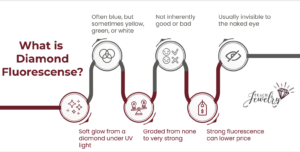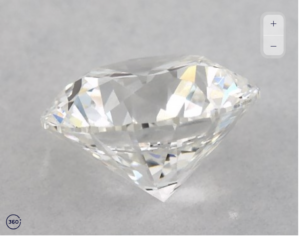
Among the most misunderstood attributes of diamond is its fluorescence. For example, it’s commonly believed fluorescence impacts the structural integrity of a diamond, leaving it more vulnerable to cracks and chips.
In fact, the presence of natural elements in diamonds causing fluorescence doesn’t weaken the hardened carbon’s binding.
If you’re deciding which diamond to purchase, there’s no doubt you’ll be introduced to the topic of fluorescence and whether it’s good or bad.
Let’s explore what fluorescence is, how it’s graded, its pros and cons, examples, and whether you should buy a diamond with fluorescence.
What is Diamond Fluorescence?
Diamond fluorescence is the glow that comes from the diamond when it is beneath ultraviolet (UV) light, whether black light or sunlight. Nearly 30% of diamonds have at least some glow.

When it’s exposed to UV light, these diamonds fluoresce other colors. The glow is blue in almost every case, but on rare occasions, it’s yellow, green, white, or red. Fluorescence either improves the color of the diamond or provides it a more hazy appearance.
Is Diamond Fluorescence Good or Bad?
Whether diamond fluorescence is good or bad depends on the color of the diamond and the degree of fluorescence. In some instances, it can disguise the yellow tint and actually make a diamond appear more colorless.
In other cases, it can make a colorless diamond have a hazy or milky appearance.
The answer also depends on your perception of the blue tint present under UV light. For some, this adds a coveted, distinct look to the diamond in specific situations. Others may want to avoid the appearance of their diamond changing colors under certain types of light.
Grades of Fluorescence
The Gemological Institute of America (GIA) grades fluorescence in diamonds but not along the traditional criteria of color, cut, clarity, and carat (the four Cs).
Instead, the GIA grades fluorescence as:
- None
- Faint
- Medium
- Strong
- Very strong
When the GIA, or other institutions such as the European Gemological Laboratory, grades diamonds along the four Cs, the quality of the diamond increases as it moves up the scale. While this is generally true of fluorescence, there’s more nuance as to whether a diamond is always of a higher quality if it has less fluorescence.
None/Faint
For a diamond graded as “none,” no soft and blue glow emits when it’s exposed to the UV light. The diamond doesn’t have trace elements causing fluorescence. This grade results in the highest premium in regard to fluorescence and may command a higher price.
With “faint,” you notice a soft blow glow when the diamond is exposed to the UV light. The diamond has minor trace elements resulting in fluorescence, but this has no other impact on the diamond’s quality.
In practical terms, there’s no difference between a none and faint grade, and it’s not recommended to pay any premium for no fluorescence over faint.
Medium
A diamond graded as “medium” fluorescence emits a light bluish glow when exposed to UV light. Medium fluorescence provides excellent value for the diamond because it won’t get a premium price but has no impact on its structure.
Its impact on appearance may sound counterintuitive. While it’s generally thought fluorescence can only have a negative impact on appearance, in the case of a medium grade, it can actually improve the look of diamonds with a color grade lower than H, such as J,K, or L.
The diamond will have additional sparkle and glisten as a result of fluorescence.
That’s because the medium blue fluorescence opposes the yellow hues of a lower-graded diamond in a way that makes it appear more colorless.
Strong/Very Strong
A strong or very strong grade means with exposure to the UV light, the diamond emits a deep blue glow. Diamonds with strong fluorescence also improve low grade colors, but on the other hand, it has a negative impact on colorless such as F, E, and D.
The combination of fluorescence with a clear white diamond can result in a hazy or gray appearance.
Pros of Fluorescence
There isn’t a clear answer to whether diamond fluorescence is good or bad, but it does have its pros in the context of finding the highest quality diamond at the lowest price.
Lower Prices
The top benefit of purchasing a diamond with fluorescence is it can reduce the price by 10-15 percent. You’ll see more significant savings if the diamond has strong or very strong fluorescence and noticeably impacts its appearance.
This relates to our example about fluorescence diminishing the appearance of colorless diamonds.
Because it has the potential to make an F, E, or D diamond more hazy, its value decreases and you can receive a lower price.
On the other hand, don’t expect the type of discount you’d earn by moving down the scale on the four Cs. Choosing a lower cut, color, clarity, or carat is what traditionally drops prices the fastest, but choosing a higher fluorescence is another route if you’re looking to stay within budget.
Unique Look
Diamond shoppers aren’t always after the highest quality diamond in the most traditional sense.
There are other types of diamonds, such as salt and pepper diamonds, that aren’t scored as high on the GIA scale but nonetheless have grown in popularity because of their uniqueness.
The same can be said about diamonds with high fluorescence.
If you’re looking for an added wow factor, the faint blue glow of your diamond under certain types of light may be exactly that feature.
The benefit of fluorescence is the visual difference is minimal to nonexistent in almost all cases, but when under the right setting, your diamond stands out from others.
You may see this as a “best of both worlds” situation and prefer the occasional glow.
Can Hide Yellow Tints
Diamonds with yellow tints are considered less valuable because they’re on the opposite end of the spectrum as colorless diamonds, which are the most valuable.
But colorless diamonds (F, E, and D) come with a price premium, and if you have a tighter budget, you’ll likely go with a “near colorless” one (G, H, I, or J.).
Near colorless diamonds, especially I and J, have a slight yellow tint, but fluorescence can actually diminish the tint and cause it to appear more white.
As a general rule, strong fluorescence can move a diamond up one letter on the color scale. That means a J color diamond could look more like an I, saving you money while giving the diamond an improved aesthetic.
Usually Invisible to the Naked Eye
A GIA study showed 30 percent of diamonds showed at least some fluorescence, but the study also concluded in the overwhelming majority of instances, fluorescence doesn’t have a noticeable impact on appearance.
The observers who represented the general public couldn’t distinguish the differences in fluorescence, and even trained jewelers disagreed on how it affected particular diamonds.
So if you’re wondering whether your friends or family will notice if your diamond has a high degree of fluorescence, the answer is it’s incredibly unlikely they will.
For example, the diamond on the left has no fluorescence. The diamond on the right is the same carat, color, clarity, and cut but has strong fluorescence. The strong fluorescence or lack of it has no noticeable impact on the appearance of the diamond in normal lighting.


Cons of Fluorescence
Whether or not there’s merit to any price drop because of it, strong fluorescence is generally thought to decrease the overall quality of a diamond. Let’s review the cons of fluorescence.
Hazy or Milky
The two words most often used to describe the impact of fluorescence on appearance are hazy or milky. You may also hear it described as oily. It could result in less transparency and hurt its overall light performance because the light won’t travel through the diamond as well.
Though the effect is minimal, it’s most pronounced in colorless diamonds. That’s because as a clear white diamond, any characteristic that adds color takes away from that.
Harder to Resell
Many diamond retailers and consumers involved in buying and selling diamonds view the fluorescence as a negative quality. This makes them harder to sell and reduces the resale price.
If you plan to resell your diamond, you may want to minimize the fluorescence to avoid giving the buyer a reason to offer a lower price. There may not be much merit to their claim, but it could be used as an excuse to avoid paying a premium price for it.
What Does Fluorescence Look Like?
If you’re examining diamonds in person or online, you likely wouldn’t notice which ones have fluorescence, which is why it’s important to see examples.
Blue Nile, an online diamond retailer, displays their best selling fluorescent diamonds.
This one-carat diamond has “strong blue” fluorescence.

As you can tell, the diamond still appears colorless and doesn’t have a blue tint under normal lighting. Blue Nile notes this diamond is considered a better value because of its strong blue fluorescence that doesn’t impact its appearance.
As another example, this 1.00-carat round diamond has an H color with strong fluorescence.
You can see it has a slight yellow tint, but this is the type of color where strong fluorescence can actually diminish the yellow and instead make the diamond appear more white.
For some of the highest quality diamonds with fluorescence, Brian Gavin has its signature “Brian Gavin Blue” line. The uniqueness of these diamonds is they all contain medium to strong fluorescence, but it doesn’t impact the diamond’s performance. For someone wanting a degree of fluorescence but worried it will impact light performance, these diamonds are the right choice.

Should You Buy a Diamond With Fluorescence?
Our recommendation about whether you should buy a diamond with fluorescence is this: As long as the fluorescence and its effects are not noticeable by the naked eye in normal lighting, it can be a great way to find a high quality diamond with a slight discount.
That concept can be applied across the many criteria involved in buying a diamond.
Find a diamond that has a lower grade so you can command a lower price, but ensure that particular quality isn’t perceptible unless it’s under a microscope.
An instance in which you shouldn’t buy a diamond with strong or very strong fluorescence is when you’re paying a premium for a colorless diamond.
This can present the scenario in which you’re paying a high price but actually getting a diamond that doesn’t appear colorless.
In light of all we’ve discussed about diamond fluorescence and whether it’s good or bad, don’t get too caught up on this quality when making your buying decision.

Jacob Clarke
Jacob Clarke is the founder of TeachJewelry.com.
He earned an Applied Jewelry Professional Diploma from the Gemological Institute of America (GIA) and now brings you essential information about diamonds, settings, and more.
Jacob has consulted with leading jewelry brands, and his work has been cited in Clean Origin, Diamond Nexus and industry publications.
He's also a member of the International Gem Society.
He enjoys discussing jewelry with readers, so contact him with any questions at jacob.clarke@teachjewelry.com.














